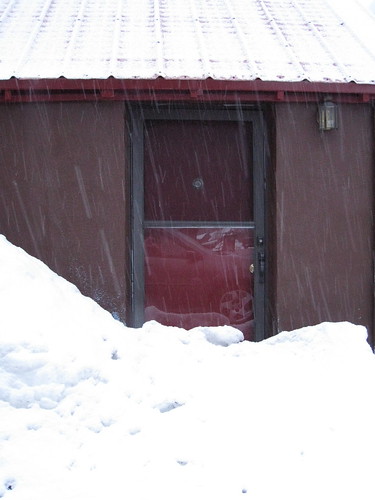Deerhunter: Microcastle (Kranky, 2008)


Microcastle is the perfect album for a snowy winter afternoon in which you find yourself at home alone in the mountains. It drifts, it floats, it accumulates. It exudes a fuzzy analog warmth and an expansive ambience that blankets the whole house (our house is cozy). Since the time that I purchased it early last November, it’s been by far my most played vinyl record, primarily because it just sounds so thick and warm and good in that format. (Don’t let that dissuade you from trying CDs or MP3s, because the analog warmth is not it’s only strength.)
The dichotomy of cool and warm sounds are what make this album so compatible with winter listening; it’s like watching that snowstorm out of the window of a fire-warmed house, while the wind is howling through the top of the door and the walls are creaking. Much of the frigidity is in the lyrics. For example, the first lines sung on the record are “Cover me, cover me / Comfort me, comfort me,” and on the track “Never Stops” (press the play button at the top of the article to listen to it if you haven’t already), you’ll learn that it’s none other than winter that never stops.
This is a tight collection of songs with just enough sonic variance around the edges to keep things interesting. The style? It’s basically 60s guitar pop/garage rock with the occasional 50s-styled rock n’ roll ballad. Think of the Byrds, think of The Zombies (“Time of the Season”), and also think of early R.E.M., Deerhunter’s fellow Georgians who also revamped this 60s style in the 80s). It’s just not that straightforward, though; the songs are stormy and occasionally obscured by a tasteful amount of ambient, shoegazer, drone, and other post-punk/indie noise tricks blowing around in the background. Think most particularly of My Bloody Valentine and Sonic Youth.
Some highlights:
- The album begins with an instrumental track called “Cover Me Slowly,” a Pink Floyd meets My Bloody Valentine widescreen slowburner which leads directly into the subtle and jangley “Agorophobia,” with the aforementioned appropriate opening lines:
- “Nothing Ever Happened,” which is just an all-around great, propulsive rock song that brings all the different sounds of the album together:
- “Neither of Us, Certainly,” because it is sonically the most snowfallingest song on the album:
- “Twilight at Carbon Lake,” the closing 6/8 ballad that starts out sounding like something Elvis might have crooned over at Sun Records, but expands and erupts into a beautiful caucaphonous climax:
A final note, to more fully secure this record’s impeccable winter credibility: On the band’s official blog (more bands should have blogs; Deerhunter’s is great), lead singer Bradford Cox wrote a post lamenting the inadvertent leaking of this album months before the intended late October release date. (I just noticed they have now removed this post from their blog, so I’m now linking to an article that quotes the post.) One of Cox’s stated sadnesses over the leak was not that the band had lost a lot of potential sales from pirating, nor so much that the leak had undermined their publicity buildup scheme for the album, but rather that he had very much envisioned this music as a “fall/winter” record, designed to be listened to initially at that time of year, rather than the summer. I love that they think about this stuff as much or more than I do, and I love that they very much succeeded in creating a wintry record.
[This album also comes with a bonus CD entitled Weird Era Cont (even with the vinyl copy this second disc is a CD). It is like standing out in that snowstorm looking longingly in through the window of that glowing, warm house. Here the production is a little rougher and songcraft is sometimes secondary to sonic experimentation. It has some real gems and greatly adds to appeal of the overall package.]


 The Order of Odd-Fish * Written by James Kennedy
The Order of Odd-Fish * Written by James Kennedy The Kingdom on the Waves * Written by M.T. Anderson
The Kingdom on the Waves * Written by M.T. Anderson The Pox Party * Written by M.T. Anderson
The Pox Party * Written by M.T. Anderson